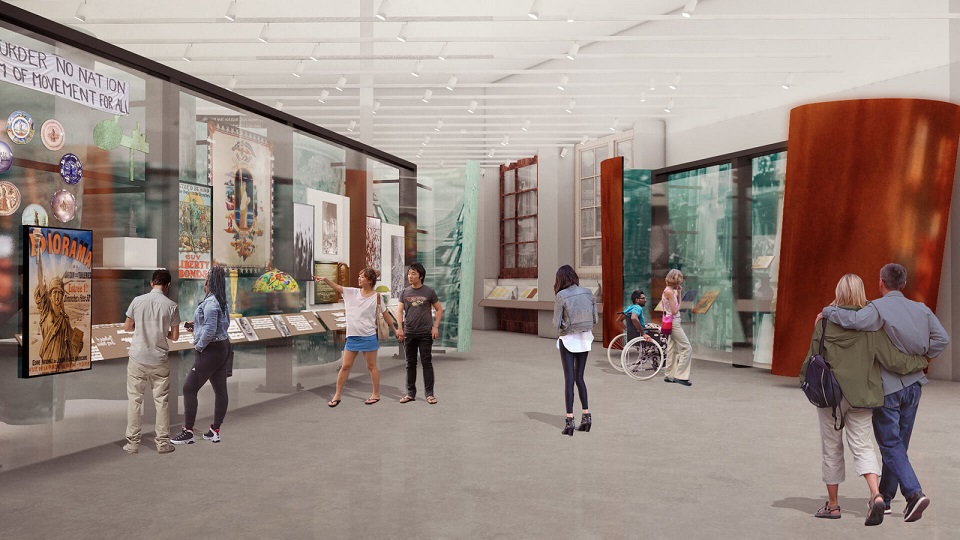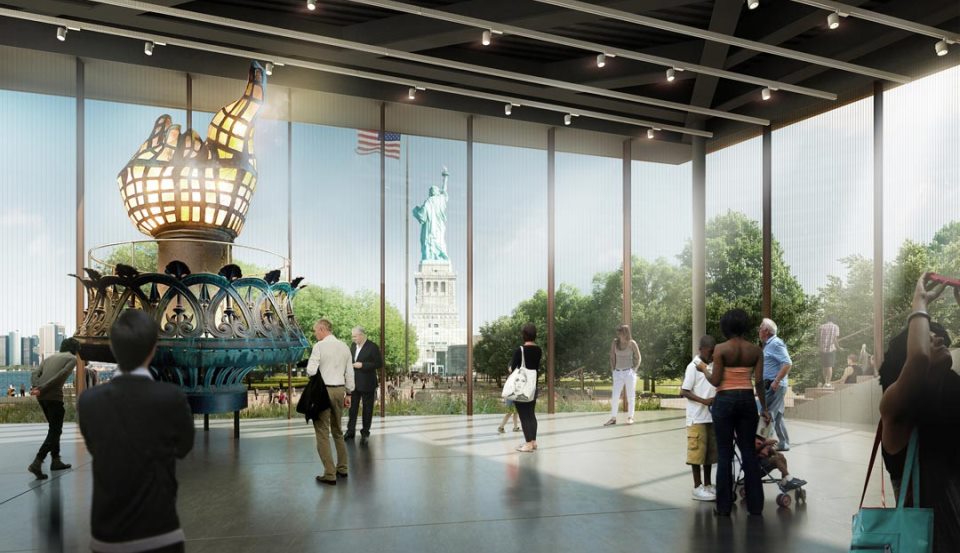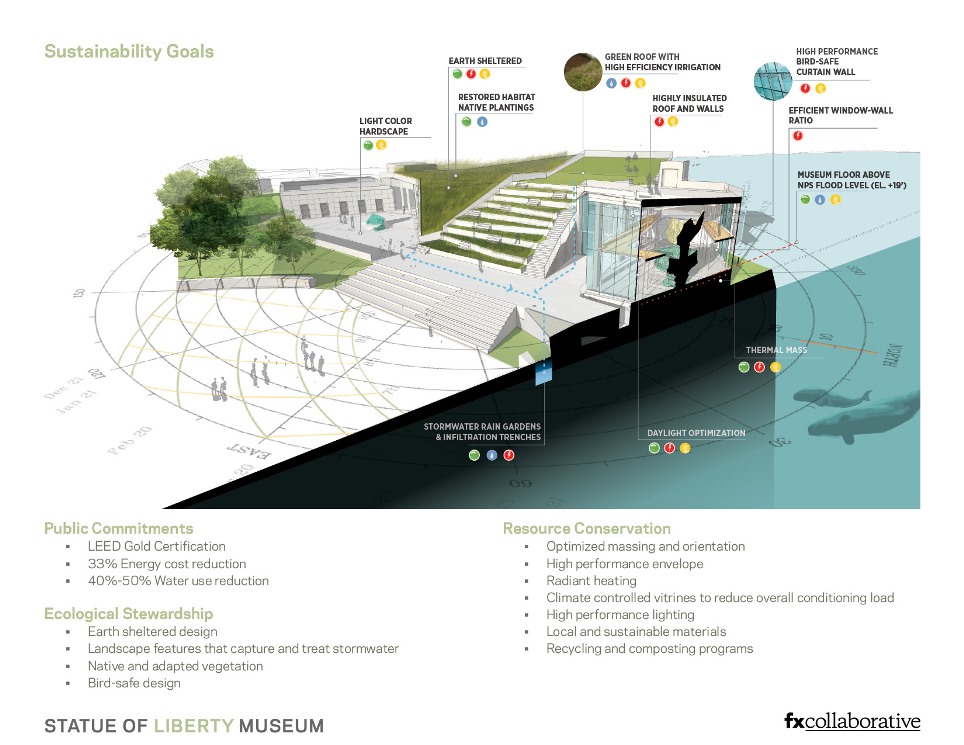
About
The Statue of Liberty Museum Project - Liberty for All.
She is an icon, a national treasure, and one of the most recognizable figures around the globe. Millions who cherish her ideals make the journey every year to experience her history and grandeur in person. She is Lady Liberty, a symbol of freedom, a worldwide icon inspiring hope. The Statue of Liberty Museum™ represents an exciting new chapter in Lady Liberty’s story of freedom. The museum gives millions more an opportunity to enjoy the Statue of Liberty experience … and we are relying on your support.
The Statue of Liberty Museum™ addresses three main components: Accessibility, Education, and Sustainability.
Accessibility:
For the first time since September 11, 2001, every visitor has the opportunity to experience meaningful artifacts and discover a deeper understanding of Lady Liberty’s history and what she stands for. In addition, the museum creates a beautiful, new destination on Liberty Island and greatly enhances the overall visitor educational experience. The Statue of Liberty Museum allows the 4.3 million annual visitors access to the museum without restrictive security clearances.
Education:
This freestanding museum allows for universal access, gving students and visitors from around the globe a more meaningful experience and deeper understanding of Lady Liberty's history. Visitors explore the museum at will—without the need for additional advanced reservations or tickets. In addition, it creates a beautiful, new destination on Liberty Island, has a positive impact on the high-volume pedestrian traffic flow and greatly enhances the overall visitor educational experience.
Sustainability:
The museum embodies an environmentally responsible design and best practices for sustainability. It features material reuse of the existing Administration Building, a green roof-scape, and bird-safe glass exteriors. In the aftermath of Hurricane Sandy, it is set above 500-year flood levels and built to withstand hurricane force winds.
The Statue of Liberty Museum™ represented a unique opportunity for The Statue of Liberty-Ellis Island Foundation to extend its legacy of environmental and cultural stewardship. Liberty Island is not only an important ecological site in the center of New York Harbor, but also embodies the combined aspirations of local, state, and federal government. Through initiatives such as New York City’s OneNYC plan, these entities are beginning to seriously address issues of sustainability in the built environment. The Statue of Liberty Museum™ responded by acting as a paradigm of sustainable design. Our approach to sustainability was driven by three core concepts: building resource use conservation, ecological stewardship, and public commitments.
We used local and responsibly harvested materials to incorporate design features that conserve energy and water. The building and landscape incorporated design features to treat storm water runoff and create habitats for local flora and fauna. Lastly, the museum made public commitments to sustainability, through LEED Certification and investments in renewable energy. Such commitments helped to clarify the project’s goals, and contributed to market transformation toward a more sustainable future.
Museum Galleries
The museum consists of three gallery spaces. Each one is meant to inspire visitors and educate them about the Statue of Liberty in interactive and thought-provoking ways.
Immersive Theater:
The Immersive Theater is a dramatic, multimedia experience lasting approximately 8-10 minutes that surrounds visitors in the sweeping story of the Statue and the ideals she represents. Weaving through this soaring theater space, museum-goers will learn the rich story of the Statue’s origins and be captivated by a virtual fly-through ascending the Statue that recreates interior views and sounds. Visitors are invited to contemplate liberty today and its measures around the world, such as access to education, free elections, and a free press.
Engagement Gallery:

In this gallery, visitors are able to explore what took place in the warehouse where Frédéric Auguste Bartholdi built the Statue. A series of multimedia displays evoke the feeling of being in the sculptor’s studio, allowing guests to see the step-by-step process of Liberty's construction, from small plaster model to the copper sheets pounded on massive negative molds to create the Statue’s final form. Throughout this section, visitors delve deep into stories about the Statue’s history, design, and role in the world, exploring the multifaceted, sometimes contested, ideals of liberty through artifacts, graphics, and interactive media.
Inspiration Gallery:
In this awe-inspiring space, visitors can reflect upon what they have seen and experienced in the museum. Guests are invited to document their visit and express their views by adding a self-portrait and collage of inspirational images to an ever-growing digital experience called Becoming Liberty. The tour culminates with an up-close view of Liberty’s most iconic symbol – her original torch – held high for nearly 100 years and still a touchstone of the light Liberty shines from generation to generation. Rescued from the elements and replaced in 1986, the torch is the most powerful artifact visitors encounter as they reach the end of their museum experience. A model of the Statue's face offers another tactile moment, and the glass walls afford magnificent views of the Statue of Liberty herself set against a stunning backdrop of the New York City skyline.
THE STATUE OF LIBERTY'S ORIGINAL TORCH:

As Bartholdi envisioned it in 1874, the flame of the Statue’s torch was not to be lighted but was to be made of solid copper sheet and gilded to shine brightly in daylight. But during its century of use, the torch underwent numerous modifications. When the Statue was dedicated in 1886, two rows of portholes had been cut from the copper at the bottom of the torch to illuminate it from inside, which permitted light to escape horizontally. Six years later, a belt of glass, 18 inches high, replaced the upper row of portholes, and an octagonal, pyramidal skylight with red, white and yellow glass was installed on top of the flame. In 1916, copper was removed in about 250 places and was replaced by amber-colored cathedral glass, but the octagonal skylight was left intact. Its new lighting included flashing lights to replicate the flicker of a natural flame. In 1931, a new lighting system was installed which called for two holes 16 inches in diameter to be cut into the floor of the balcony around the flame, with two projectors installed beneath the torch balcony.
The 1980s Statue restoration team decided the upper torch and flame would have to be replaced. A century of modification had radically altered Bartholdi’s solid copper flame to one mainly of glass. As a result of rainwater leakage, the original torch above the handle had become damaged beyond repair. It was removed on July 4, 1984 and later displayed in the pedestal museum. The original torch is on display in its new home in the Inspiration Gallery.
New Opportunities

The former museum inside the pedestal only accommodated a fraction of the Island’s visitors. The Statue of Liberty Museum™, accessible and free to all, welcomes every visitor and greatly improves the Lady Liberty experience.
The Statue of Liberty Museum:
- Creates a new cultural attraction and more engaging tour at Liberty Island
- Enhances access and educational content for school groups
- Fosters a sense of inclusion for all visitors, regardless of physical limitations
- Offers a venue to enjoy performances and events hosted at the flag plaza
- Preserves existing open spaces for public enjoyment
The Statue of Liberty Museum is designed to engage visitors through state-of-the-art experiential exhibits, as well as a significant collection of cultural artifacts.
Collaborative efforts with the National Park Service/U.S. Department of the Interior, architecture firm FXCollaborative and ESI Design have led to this new museum. According to principles established by the National Park Service, new development must respect and defer to both the Statue herself, and the natural majesty of the setting.
Just as the dedication of people who believed in the ideals of liberty helped to realize the dream of the Statue 130 years ago, we hope that this Statue of Liberty Museum will inspire your generosity as we continue to preserve and restore the Statue of Liberty and Ellis Island.
